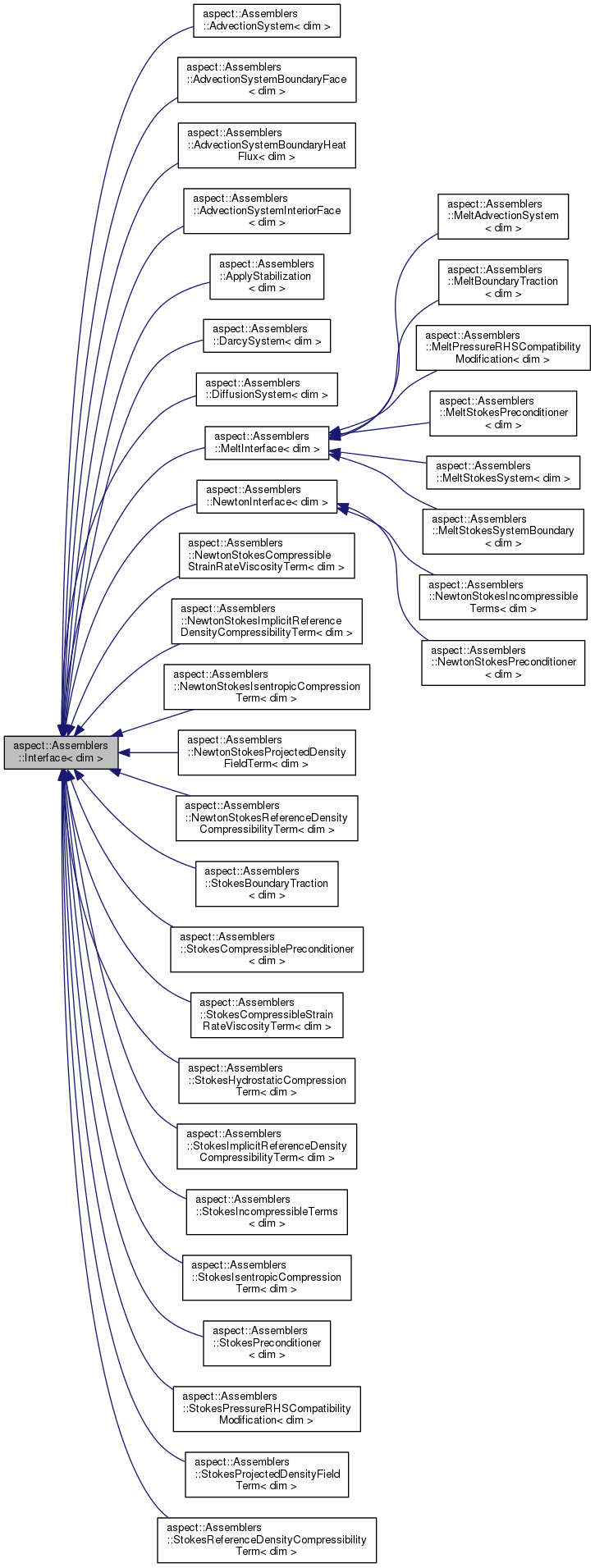 |
ASPECT
|
 |
ASPECT
|

Public Member Functions | |
| virtual void | execute (internal::Assembly::Scratch::ScratchBase< dim > &scratch, internal::Assembly::CopyData::CopyDataBase< dim > &data) const =0 |
| virtual void | create_additional_material_model_outputs (MaterialModel::MaterialModelOutputs< dim > &) const |
| virtual std::vector< double > | compute_residual (internal::Assembly::Scratch::ScratchBase< dim > &) const |
 Public Member Functions inherited from aspect::Plugins::InterfaceBase Public Member Functions inherited from aspect::Plugins::InterfaceBase | |
| virtual | ~InterfaceBase ()=default |
| virtual void | initialize () |
| virtual void | update () |
| virtual void | parse_parameters (ParameterHandler &prm) |
| virtual void | save (std::map< std::string, std::string > &status_strings) const |
| virtual void | load (const std::map< std::string, std::string > &status_strings) |
Additional Inherited Members | |
 Static Public Member Functions inherited from aspect::Plugins::InterfaceBase Static Public Member Functions inherited from aspect::Plugins::InterfaceBase | |
| static void | declare_parameters (ParameterHandler &prm) |
A base class for objects that implement assembly operations.
The point of this class is primarily so that we can store pointers to such objects in a list. The objects are created in Simulator::set_assemblers() and destroyed in the destructor of the Simulator object. Derived classes of this base class usually handle groups of terms in the equations that are logically connected (such as all terms in the Stokes equations that appear independent on the selected compressibility formulation). This way selecting a certain set of assembler objects effectively controls which equation is solved.
Definition at line 135 of file simulator.h.
|
pure virtual |
Execute this assembler object. This function performs the primary work of an assembler. More precisely, it uses information for the current cell that is stored in scratch (like the material properties on this cell and the position of quadrature points) and computes the matrix and right hand side contributions for a set of terms for the given cell. These contributions are stored in data. Note, that the data in scratch and data is shared between all active assemblers so that each assembler should only add contributions to data, not overwrite entries in the matrix. After all assemblers have finished, the final content of data is distributed into the global matrix and right hand side vector.
Implemented in aspect::Assemblers::NewtonStokesProjectedDensityFieldTerm< dim >, aspect::Assemblers::MeltBoundaryTraction< dim >, aspect::Assemblers::MeltPressureRHSCompatibilityModification< dim >, aspect::Assemblers::NewtonStokesIsentropicCompressionTerm< dim >, aspect::Assemblers::NewtonStokesImplicitReferenceDensityCompressibilityTerm< dim >, aspect::Assemblers::MeltAdvectionSystem< dim >, aspect::Assemblers::MeltStokesSystemBoundary< dim >, aspect::Assemblers::NewtonStokesReferenceDensityCompressibilityTerm< dim >, aspect::Assemblers::MeltStokesSystem< dim >, aspect::Assemblers::NewtonStokesCompressibleStrainRateViscosityTerm< dim >, aspect::Assemblers::MeltStokesPreconditioner< dim >, aspect::Assemblers::NewtonStokesIncompressibleTerms< dim >, aspect::Assemblers::NewtonStokesPreconditioner< dim >, aspect::Assemblers::StokesPressureRHSCompatibilityModification< dim >, aspect::Assemblers::StokesBoundaryTraction< dim >, aspect::Assemblers::StokesHydrostaticCompressionTerm< dim >, aspect::Assemblers::StokesProjectedDensityFieldTerm< dim >, aspect::Assemblers::StokesIsentropicCompressionTerm< dim >, aspect::Assemblers::AdvectionSystemInteriorFace< dim >, aspect::Assemblers::AdvectionSystemBoundaryFace< dim >, aspect::Assemblers::StokesImplicitReferenceDensityCompressibilityTerm< dim >, aspect::Assemblers::AdvectionSystemRobinBoundary< dim >, aspect::Assemblers::StokesReferenceDensityCompressibilityTerm< dim >, aspect::Assemblers::AdvectionSystemBoundaryHeatFlux< dim >, aspect::Assemblers::StokesCompressibleStrainRateViscosityTermAnisotropicViscosity< dim >, aspect::Assemblers::StokesCompressibleStrainRateViscosityTerm< dim >, aspect::Assemblers::StokesIncompressibleTermsAnisotropicViscosity< dim >, aspect::Assemblers::DiffusionSystem< dim >, aspect::Assemblers::StokesIncompressibleTerms< dim >, aspect::Assemblers::StokesCompressiblePreconditionerAnisotropicViscosity< dim >, aspect::Assemblers::ApplyStabilization< dim >, aspect::Assemblers::StokesCompressiblePreconditioner< dim >, aspect::Assemblers::DarcySystem< dim >, aspect::Assemblers::EntropyAdvectionSystem< dim >, aspect::Assemblers::AdvectionSystem< dim >, aspect::Assemblers::StokesPreconditionerAnisotropicViscosity< dim >, and aspect::Assemblers::StokesPreconditioner< dim >.
|
virtual |
This function gets called if a MaterialModelOutputs is created and allows the assembler to attach AdditionalOutputs. The function might be called more than once for a MaterialModelOutput, so it is recommended to check if MaterialModelOutputs<dim>::get_additional_output_object() returns an instance before adding a new one to the additional_outputs vector. By default this function does not create additional outputs.
Material models, through functions derived from MaterialModel::Interface::evaluate(), put their computed material parameters into a structure of type MaterialModel::MaterialModelOutputs. By default, material models will compute those parameters that correspond to the member variables of that structure. However, there are situations where parts of the simulator need additional pieces of information; a typical example would be the use of a Newton scheme that also requires the computation of derivatives of material parameters with respect to pressure, temperature, and possibly other variables.
The computation of such additional information is controlled by the presence of a collection of pointers in MaterialModel::MaterialModelOutputs that point to additional objects. Whether or not one needs these additional objects depends on what assemblers are selected, or what postprocessing one wants to compute. For the purpose of assembly, the current function creates the additional objects (such as the one that stores derivatives) and adds pointers to them to the collection, based on what this assembler class requires. This function is always called before the material model is evaluated and execute() is called. This ensures the additional material model output is available when execute() is called.
Reimplemented in aspect::Assemblers::NewtonStokesIncompressibleTerms< dim >, aspect::Assemblers::MeltInterface< dim >, aspect::Assemblers::NewtonStokesPreconditioner< dim >, aspect::Assemblers::NewtonInterface< dim >, aspect::Assemblers::StokesIncompressibleTermsAnisotropicViscosity< dim >, aspect::Assemblers::StokesIncompressibleTerms< dim >, aspect::Assemblers::DarcySystem< dim >, aspect::Assemblers::StokesPreconditionerAnisotropicViscosity< dim >, and aspect::Assemblers::StokesPreconditioner< dim >.
|
virtual |
A required function for objects that implement the assembly of terms in an equation that requires the computation of residuals (in particular the advection equation in ASPECT). Just like the assemblers itself, the residual that we use to compute the necessary entropy viscosity depend on the equation (i.e. which terms are actually included in the equation). Thus different objects compute different residuals (i.e. the residual for a melt advection equation looks different from the residual for a passive compositional field). For assemblers for the Stokes system, an implementation of this function is not necessary.
Reimplemented in aspect::Assemblers::MeltAdvectionSystem< dim >, aspect::Assemblers::DiffusionSystem< dim >, aspect::Assemblers::DarcySystem< dim >, aspect::Assemblers::EntropyAdvectionSystem< dim >, and aspect::Assemblers::AdvectionSystem< dim >.